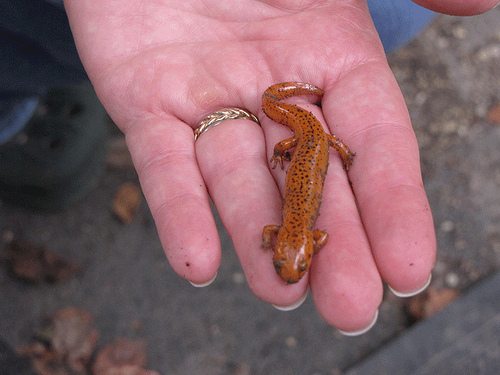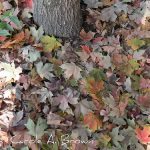Last week I wrote about playing in the leaves with kids and what a wonderful opportunity this was for children to discover the plethora of wildlife who make their home in the leaf litter.
And I received a twitter message from my friend, Kylee Baumle (@OurLittleAcre) who said:
Hi Carole! I read your article & agree with most of it except for the raking. Depends on where leaves fall & how many you have!
And we proceeded to have a friendly back and forth discussion about the value of leaf litter for wildlife and Kylee’s concerns about diseases and the fact that she has just too many leaves to deal with in her garden. Kylee’s view of The Problem With Leaves expresses this other side of this conversation.
Different Kinds of Gardeners
We’ve all met different kinds of gardeners. There are ornamental gardeners who aspire to have a garden worthy of showcasing in the pages of Fine Gardening or Horticulture. There are vegetable gardeners who proudly feed their families (and neighborhood) with the bounty of their land. And there are passionate wildlife gardeners who find great joy from a new bird or butterfly who has chosen to visit their wildlife garden. And there are gardeners who enjoy all of the above.
I am a wildlife gardener. Personally, the entire reason that I garden is to create habitats for wildlife, and every choice that I make in my garden is made with the needs of wildlife as a top priority.
What is beautiful to me is not the individual “specimens” of plants scattered through a garden, but the birds, butterflies, bees, insects, frogs and toads, and other wildlife who make their home in gardens that I have created. These gardens are beautiful because they are full of life, and the plants are only a vehicle to that end.
And happily, my garden will never appear in the pages of Fine Gardening.
Kylee, on the other hand, is an ornamental gardener, albeit with an admitted joy in discovering new butterflies, moths, and other insects in her garden, which she happily shows off on twitter. But the fact remains that we garden for different reasons.
She likes ornamental plants and the latest cultivars. I like wildlife and I choose only plants that have the most value to them. Don’t get me wrong, Kylee loves wildlife, too. But she does feel buried under the many, many leaves that fall on her property, and feels like there can be too much of a good thing. We’re different. And that’s ok. We can discuss our views in a friendly way, even though we know we disagree. I like that in a person.
There are several issues which seem to stir up a lot of controversy and angry words between wildlife gardeners and ornamental gardeners. One is the subject of native plants. The other is the subject of fallen leaves and general garden neatness. This is not the place for angry words. Just sayin’ ![]()
Leaving the Leaves in Place is Good For Wildlife
An amazing array of wildlife makes their home in the leaf litter, including spiders, many butterflies and moths in various life stages, other insects, salamanders, frogs and toads, and other wildlife. One of the biggest joys of my life is watching the many birds who spend all winter and spring picking through my leaves in search of something good to eat.

Salamanders live in the leaf litter © 2010 Carole A. Brown
All of the fallen leaves on my property stay in my garden. And I live in a neighborhood where the homes are more than 100 years old and so are the many trees. There’s a lot of leaves. I like that.
I do rake the pathways and pile them into my garden beds. But not one leaf that falls on my property is bagged up and trucked away. In fact, I drive around the neighborhood in the fall and pick up those paper bags of other people’s leaves.
I go in to the winter with about two feet of leaves piled high in each garden area. After the snow melts I walk around the garden with a hand rake and just loosen up the packed leaves. All of my plants happily poke their heads right through them in the spring. And by the time next autumn rolls around, there are none left.

Now, just because I collect every leaf in the neighborhood does not mean that I’m saying this is an all or nothing issue for you.
Gardening for wildlife and biodiversity, as with so many other choices, includes options along a continuum that are really bad for wildlife, to those that are better, to those that are the best possible choices for wildlife conservation and biodiversity. Every gardener will have to come to terms with where their choices fall along this continuum, but each of us has a duty to become responsible stewards of our own little piece of Mother Earth.
So what I’m saying is that some leaves in your wildlife garden is good. Lots of leaves is better for the wildlife who make their home there. I vote for the wildlife. You will cast your vote as you can.
Do Leaves Make the Garden Look Messy?
Well, it depends on how you define messy or beauty. I find beauty in the critters who live in my leaves.
My friend Genevieve Schmidt (@NCoastGardening) is not so sure about that. She has joined this conversation with the Evolution of a Gardener: Finding the Middle Ground Between Neat and Natural.
It seems another article I wrote about the life in the leaf litter got Genevieve to thinking about how to provide more for wildlife and maintain her sense of aesthetic beauty.
My point is each of us gardens for different reasons. The conditions in my garden are very different even than my neighbor’s across the street, let alone my friends in Florida or Arizona. There is no one best way to do things. Each of us needs to make the best choices that we are able to.
More From Ecosystem Gardening:
Submit your review | |








